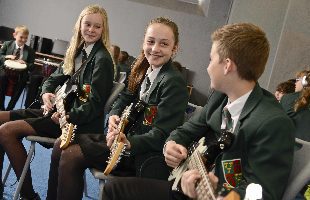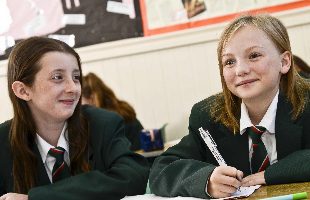Maths
Without mathematics, there’s nothing you can do. Everything around you is mathematics. Everything around you is numbers.
Shakuntala
Year 7
The Rationale:
We want students to be numerate, have strong problem solving skills and be able to apply mathematical techniques to everyday situations in the real world. We want them to have confidence in their maths skills and have strong results at GCSE and/or A-Level to enable their next steps in education and beyond.
- To create a positive attitude to mathematics and to develop, maintain and stimulate pupils’ curiosity, interest and enjoyment in mathematics
- To develop pupils’ familiarity, skills and fluency with appropriate numerical and mathematical concepts, principles, methods and vocabulary
- To develop pupils’ understanding of mathematics in its widest context, to see how it relates to themselves outside school and to appreciate the purpose, power and relevance of mathematics
- To appreciate the rigour of mathematical proof and be able to present a reasoned argument.
- To encourage pupils to develop perseverance, initiative, self-confidence and independence in mathematics
- To enable pupils to work independently and as part of a team
- To ensure all pupils have equal access to mathematics and to experience success in their work.
| Autumn Term 1 | Autumn Term 2 | Spring Half Term 3 | Spring Half Term 4 | Summer Term 5 | Summer Term 6 | |
|---|---|---|---|---|---|---|
| Curriculum Knowledge | Whole number and decimal calculations Negative numbers Place value and powers of 10 Rounding Fractions | Percentages Introduction to algebra Expressions and formulae Measures, perimeter and area | 3D shapes and volume Factors and multiples Ratio and proportion | Statistical diagrams Averages Equations | Probability Angles and 2D shapes Constructions | Coordinates and graphs Sequences Transformations and symmetry |
| Subject Skills | Mental and written methods for calculations. Equivalent fractions and fraction calculations | Use calculator and mental methods for percentage problems. Use algebra generalise problems. Substitute values into formulae including those for area | Solve problems with volume. Find highest common factors and lowest common multiples Apply ratio and proportion to solve real life problems. | Collect record and analyse data. Solve algebra equations | Use fractions and decimals to consider the likelihood of events happening. Measure and draw angles and shapes and calculate with angle relationships | Use coordinates to identify location.Draw and read graphs of algebra equations and real life situations. Reflect, rotate and translate shapes |
| How can you help your child engage with the content? | https://hegarty maths.com/ | https://hegarty maths.com/ | https://hegarty maths.com/ | https://hegarty maths.com/ | https://hegarty maths.com/ | https://hegarty maths.com/ |
Curriculum Opportunities
UK Junior Maths Challenge
Puzzle of the week
Maths clinic every Wednesday 3pm – 4pm in M7
Career Week
Many jobs include Maths such as bank manager, teacher, air traffic controller, engineer, doctor, scientist, meteorologist, computer games designer etc…
|
|
www.careerpilot.org.uk/job-sectors/subject/maths#link-1
|
Year 8
The Rationale:
We want students to be numerate, have strong problem solving skills and be able to apply mathematical techniques to everyday situations in the real world. We want them to have confidence in their maths skills and have strong results at GCSE and/or A-Level to enable their next steps in education and beyond.
- To create a positive attitude to mathematics and to develop, maintain and stimulate pupils’ curiosity, interest and enjoyment in mathematics
- To develop pupils’ familiarity, skills and fluency with appropriate numerical and mathematical concepts, principles, methods and vocabulary
- To develop pupils’ understanding of mathematics in its widest context, to see how it relates to themselves outside school and to appreciate the purpose, power and relevance of mathematics
- To appreciate the rigour of mathematical proof and be able to present a reasoned argument.
- To encourage pupils to develop perseverance, initiative, self-confidence and independence in mathematics
- To enable pupils to work independently and as part of a team
- To ensure all pupils have equal access to mathematics and to experience success in their work.
| Autumn Term 1 | Autumn Term 2 | Spring Half Term 3 | Spring Half Term 4 | Summer Term 5 | Summer Term 6 | |
|---|---|---|---|---|---|---|
| Curriculum content | Number properties HCF and LCM Rounding Index laws Standard form Manipulating algebra | Formulae Angles Bearings Properties of shapes Perimeter and area of 2D shapes | Statistical diagrams Averages Fractions, decimals and percentages Fraction calculations | Percentage calculations Ratio Proportion Probability | Coordinates and graphs Real life graphs Pythagoras’ Theorem Equations Sequences | Properties of 3D shapes Volume Surface area Constructions Loci |
| Key Skills | Solve real life problems with HCF and LCM. Extend calculation skills to very large numbers. Expand and factorise algebra expressions. | Substitute into and rearrange formulae. Measure and draw bearings. Use angle relationships and shape properties to solve geometrical problems. | Collect record and analyse data. Convert between fractions, decimals and percentages | Solve real life problems with percentages, ratio and proportion. Consider the likelihood of events and combined events using appropriate diagrams. | Draw and read graphs of algebra equations and real life situations. Apply Pythagoras to find lengths in real life triangle problems. Extend techniques for solving equations. Explore relationships between terms in number sequences | Solve problems with volume, with links to liquids and capacity. Use compasses and ruler to draw angle and line bisectors and link to loci problem solving. |
| How can you engage with your child? | https://hegarty maths.com/ | https://hegarty maths.com/ | https://hegarty maths.com/ | https://hegarty maths.com/ | https://hegarty maths.com/ | https://hegarty maths.com/ |
Curriculum Opportunities
UK Junior Maths challenge
Puzzle of the week
Maths clinic every Wednesday 3pm – 4pm in M7
Career Links
Many jobs include Maths such as bank manager, teacher, air traffic controller, engineer, doctor, scientist, meteorologist, computer games designer etc…
|
|
www.careerpilot.org.uk/job-sectors/subject/maths#link-1
|
Year 9
The Rationale:
We want students to be numerate, have strong problem solving skills and be able to apply mathematical techniques to everyday situations in the real world. We want them to have confidence in their maths skills and have strong results at GCSE and/or A-Level to enable their next steps in education and beyond.
- To create a positive attitude to mathematics and to develop, maintain and stimulate pupils’ curiosity, interest and enjoyment in mathematics
- To develop pupils’ familiarity, skills and fluency with appropriate numerical and mathematical concepts, principles, methods and vocabulary
- To develop pupils’ understanding of mathematics in its widest context, to see how it relates to themselves outside school and to appreciate the purpose, power and relevance of mathematics
- To appreciate the rigour of mathematical proof and be able to present a reasoned argument.
- To encourage pupils to develop perseverance, initiative, self-confidence and independence in mathematics
- To enable pupils to work independently and as part of a team
- To ensure all pupils have equal access to mathematics and to experience success in their work.
| Autumn Term 1 | Spring Half Term 3 | Spring Half Term 3 | Spring Half Term 4 | Summer Term 5 | Summer Term 6 | |
|---|---|---|---|---|---|---|
| Curriculum content | Rounding and bounds Standard form Index laws Compound measures Surds | Factorising Equations Perimeter Area Surface Area and volume | Bearings Angles Similarity and congruency Coordinates and linear graphs Quadratic and cubic graphs Real life graphs | Fractions, decimals and percentage Ratio Proportion | Summary statistics Simultaneous equations Sequences | Pythagoras’ Theorem Trigonometry Probability Tree diagrams |
| Key Skills | Find error intervals for measurements. Calculate with powers. Manipulate and use surds to give exact answers. | Expand and factorise more complex expressions. Solve linear and quadratic equations. | Measure and draw bearings. Use angle relationships and shape properties to solve geometrical problems. Explore the properties of algebraic graphs. | Use mental, written and calculator methods with fractions, decimals and percentages. Solve problems with ratio and direct and inverse proportion. | Use averages and cumulative frequency to analyse data. Model and solve problems with simultaneous equations. Find position rules in sequences | Solve missing side or angle problems with right-angled triangles. Use probability to find expected results and combine events with tree diagrams. |
| How can you engage with your child? | https://hegarty maths.com/ | https://hegarty maths.com/ | https://hegarty maths.com/ | https://hegarty maths.com/ | https://hegarty maths.com/ | https://hegarty maths.com/ |
Curriculum Opportunities
UK Intermediate Maths challenge
Puzzle of the week
Maths clinic every Wednesday 3pm – 4pm in M7
Career Links
Many jobs include Maths such as bank manager, teacher, air traffic controller, engineer, doctor, scientist, meteorologist, computer games designer etc…
|
|
www.careerpilot.org.uk/job-sectors/subject/maths#link-1
|






